Autoscaling Pods vertically using a Vertical Pod Autoscaler
In the previous section, we have been managing requests and limits for the compute resources manually. Setting these values correctly requires some accurate human guessing, observing metrics, and performing benchmarks to adjust. Using overly high requests values will result in a waste of compute resources, whereas setting it too low may result in Pods being packed too densely and having performance issues. Also, in some cases, the only way to scale the Pod workload is to do it vertically by increasing the amount of compute resources it can consume. For bare-metal machines, this would mean upgrading the CPU hardware and adding more physical RAM memory. For containers, it is as simple as allowing them more of the compute resource quotas. This works, of course, only up to the capacity of a single Node. You cannot scale vertically beyond that unless you add more powerful Nodes to the cluster.
To help resolve these issues, Kubernetes...
































































